PERIKLES (c. 490–429 BC) Ancient Greek politician, strategist...

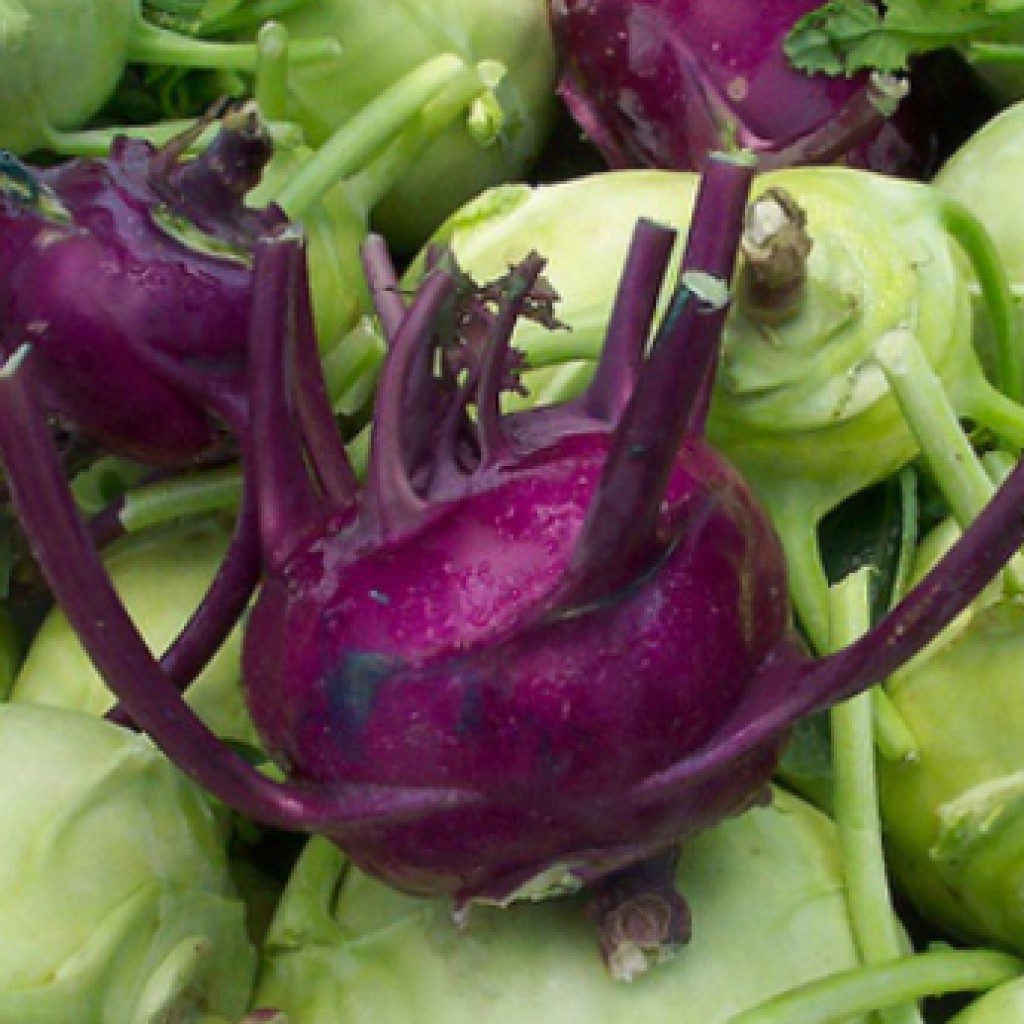
Kohlrabi is a biennial plant belonging to the class of cabbage crops. The edible part of the vegetable is a semicircular stalk, from which 3-5 long leaves grow. Because of the characteristic shape of the kohlrabi stem, the common people call it "cabbage turnip". The plant is classified as a highly nutritious product, since it contains many useful substances (easily digestible carbohydrates, vitamins, minerals, dietary fiber).
The first mention of kohlrabi was recorded as early as the 16th century AD. The Romans called the vegetable "caulorapa", which means "stem turnip". In the old days, kohlrabi was considered a weed culture, which is why it was consumed only by the poor sections of society. The plant gained real popularity only in the 17th century, when German peasants started growing vegetables.
The homeland of kale is the island of Sicily, from where it spread throughout the continent. To date, kohlrabi is grown in almost all countries of Europe, America and Central Asia. In addition, due to its cold-resistant properties, the plant is cultivated in the northern regions of Russia (Sakhalin and Kamchatka).
In appearance, the vegetable resembles a rounded turnip, and in taste, it resembles the core of white cabbage. However, unlike its “brothers”, it has a more juicy sweet pulp containing about 90% water. The diameter of the average kohlrabi stalks is 7-10 cm, and the weight is 200-600 g. The color varies from light green to dark purple.
The vegetable is classified as an early ripening crop, since its growing season is only 2-2.5 months. In view of this, in one season it is possible to collect from 2 to 3 cabbage crops. Interestingly, early varieties of kohlrabi are unsuitable for long-term storage (as they have tender flesh). Late types of cabbage have a denser core, which increases their shelf life.
Root crops are stored in the basement, after sprinkling with moistened sand.
Kohlrabi is classified as a dietary product, since 100 g of its pulp contains no more than 44 kcal. However, despite the low, the vegetable has a high nutritional value(due to the content of vitamins, minerals, saccharides, antibacterial substances, dietary fiber,).
The leaves of cabbage turnip contain 2 times more nutrients than the stem.
| Name | Nutrient content in 100 grams of raw product, milligrams |
|---|---|
| vitamins | |
| 52 | |
| 1,2 | |
| 0,2 | |
| 0,17 | |
| 0,17 | |
| 0,06 | |
| 0,05 | |
| 0,018 | |
| 0,008 | |
| 370 | |
| 50 | |
| 46 | |
| 30 | |
| 10 | |
| 0,6 | |
| 0,14 | |
| 0,13 | |
| 0,03 | |
| 0,0007 | |
The pulp of kohlrabi contains natural antitumor and anticarcinogenic activity (sulforaphane, synegrin, indole-3-carbinol).
 Cabbage turnip, due to its low calorie content and high nutritional value, is successfully used in dietology.
Cabbage turnip, due to its low calorie content and high nutritional value, is successfully used in dietology.
Beneficial features:
 Contraindications to the consumption of kohlrabi cabbage (raw):
Contraindications to the consumption of kohlrabi cabbage (raw):
If flatulence occurs against the background of vegetable consumption, the diet is enriched with spices (dill, fennel, cloves). In addition, bacteria (probiotics) are introduced into the daily menu, since gas formation in 90% of cases signals a weakening of the microflora.
Kohlrabi cabbage is less demanding on growing conditions than other plants of the cruciferous family. In addition, it is resistant to cold and perfectly "gets along" with vegetable crops. The optimum temperature for its growth is 15-18 degrees. If this indicator falls below +6 degrees (within 5 days), young plants are pulled into stems (no stalk is formed).
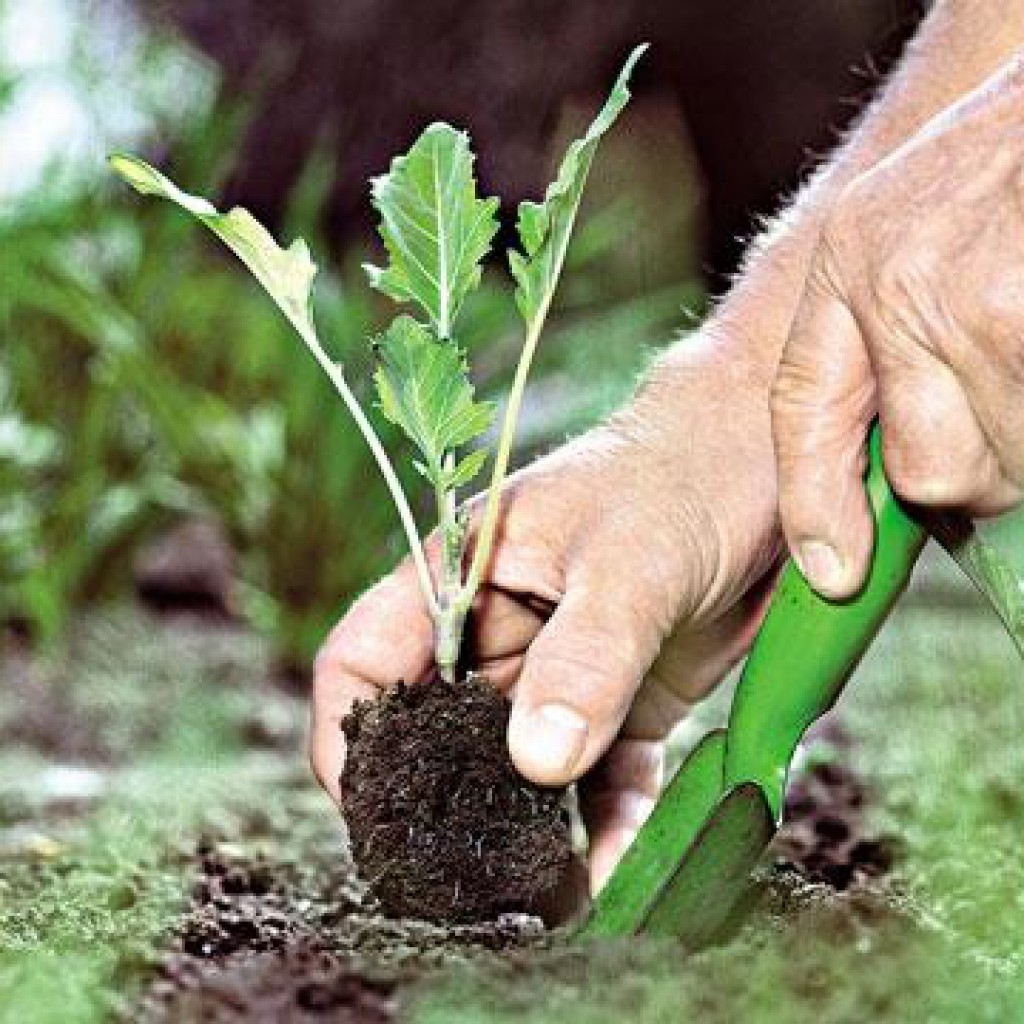 Cabbage "turnip" prefers slightly acidic and neutral soils (pH 5.5-6.8). In addition, for the successful cultivation of a vegetable, it is important to maintain a constant soil moisture (due to the superficial root system). With a lack of fluid, spherical stems become woody, and then covered with small cracks.
Cabbage "turnip" prefers slightly acidic and neutral soils (pH 5.5-6.8). In addition, for the successful cultivation of a vegetable, it is important to maintain a constant soil moisture (due to the superficial root system). With a lack of fluid, spherical stems become woody, and then covered with small cracks.
Kohlrabi is grown both by seedling and by sowing. To obtain an early harvest (in May), the grains are planted in boxes at the end of February. To collect vegetables in the summer, the seeds are placed in peat cups in mid-April.
To get an autumn harvest, the crop is planted in a greenhouse in early July. After the emergence of seedlings, the containers are transferred to a cool place (10-15 degrees). IN open ground seedlings dive in phase 5-6 of this leaf (pre-hardened). The duration of seed growth (from sowing to picking) is 35-45 days.
Remember, before planting a cruciferous crop, it is important to carefully prepare the soil. To do this, they dig up the soil (without turning the layer), and then apply nitrogen fertilizers (you can use manure compost).
The best predecessors for kohlrabi are tomatoes, onions, and grain (winter) crops. After planting the plants (at a distance of 20 cm from each other), the soil is compacted and watered abundantly with water.
Late varieties of kohlrabi are sown in open ground (in mid-May). In this case, each grain is placed in a separate hole 2 cm deep. After the appearance of the 2nd leaf, the seedlings are thinned out.
Cabbage care comes down to regular watering, loosening the soil and weeding. In addition, twice during the growing season, the plant is fed with fertilizers: 2 weeks after planting - with fermented organic matter, and after 20 days with a solution of superphosphate with potassium.
The harvest time is determined by the stem: if a scratch remains on the “turnip” after holding it with a fingernail, the stalk has ripened.
For the preparation of medicinal potions, juice and tops of fresh stems are used. Remember, infusions, decoctions, turnip cocktails cannot replace full-fledged drug therapy, they are used as an aid in the fight against the disease.
Compositions based on kohlrabi are effective in the treatment of bronchial asthma, beriberi, influenza, neurosis, weeping wounds that do not heal for a long time, anemia, gingivitis, stomatitis, and hypoacid gastritis.
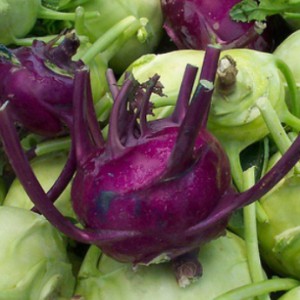 Folk recipes:
Folk recipes:
The drink is taken three times a day for 70-100 ml (in the form of heat). With good tolerance, a single dose is increased to 200 ml (gradually). The course of treatment is 30-60 days. After 4-6 months, cabbage therapy is repeated (if necessary).
Fresh kohlrabi juice is used for colds, hypoacid gastritis (reduced secretion of gastric juice), hepatitis, cholecystitis, anemia, insomnia, menopausal neurosis.
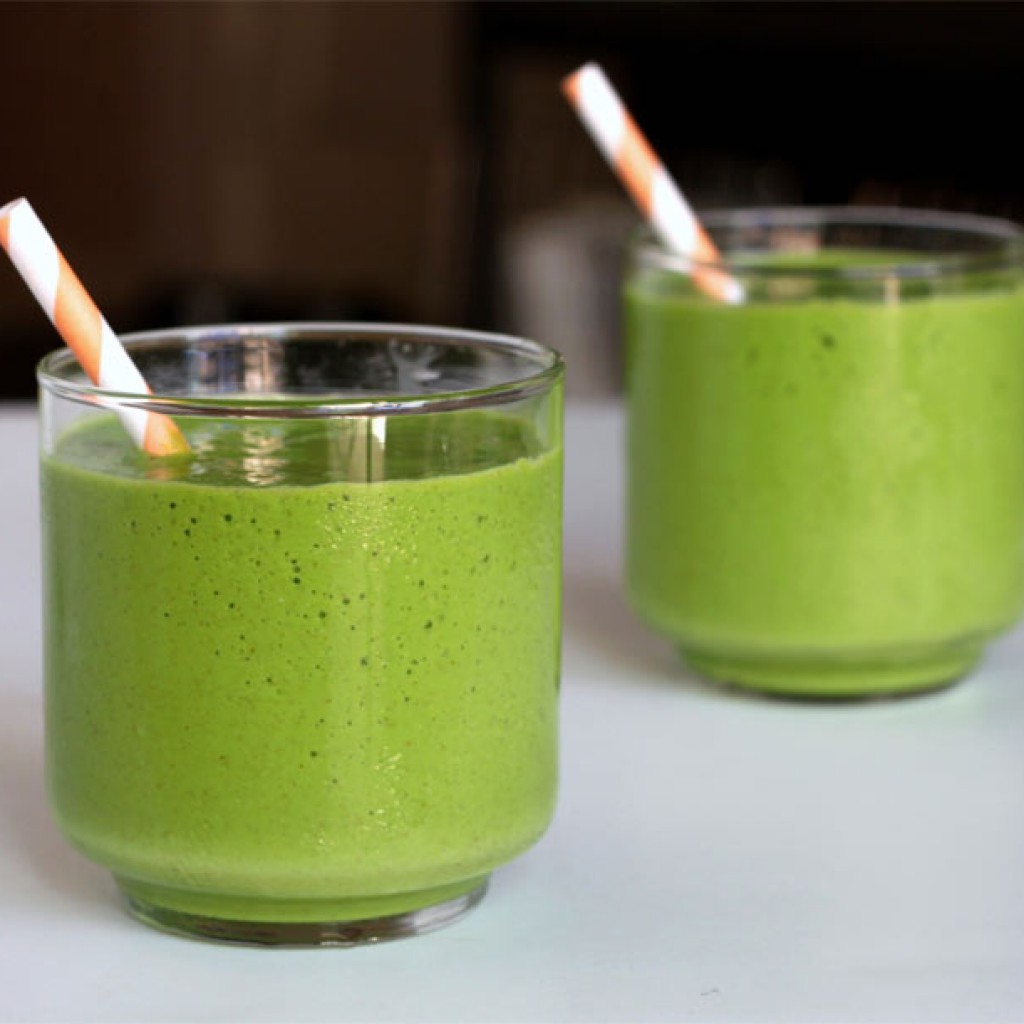 With an exacerbation of pancreatitis, gastritis (hyperacid) or ulcers, it is better to refuse to take this remedy.
With an exacerbation of pancreatitis, gastritis (hyperacid) or ulcers, it is better to refuse to take this remedy.
People suffering from nervous disorders are advised to include as many cabbage dishes as possible in their diet. These products contain vitamins C and B, which normalize the psycho-emotional background of a person.
Remember, cabbage juice is consumed only when it is warm (to avoid flatulence, belching, heartburn and pain).
The pulp of kohlrabi contains caustic isothiocyanate (allylic mustard oil), which irritates the mucous membranes of the stomach. To remove the "poisonous" ether, cabbage juice is heated in a water bath for 2-3 minutes (with constant stirring).
 Due to the high concentration of nutrients, kohlrabi is successfully used in the cosmetic industry. Based on this product, anti-aging masks are prepared for oily and aging facial skin.
Due to the high concentration of nutrients, kohlrabi is successfully used in the cosmetic industry. Based on this product, anti-aging masks are prepared for oily and aging facial skin.
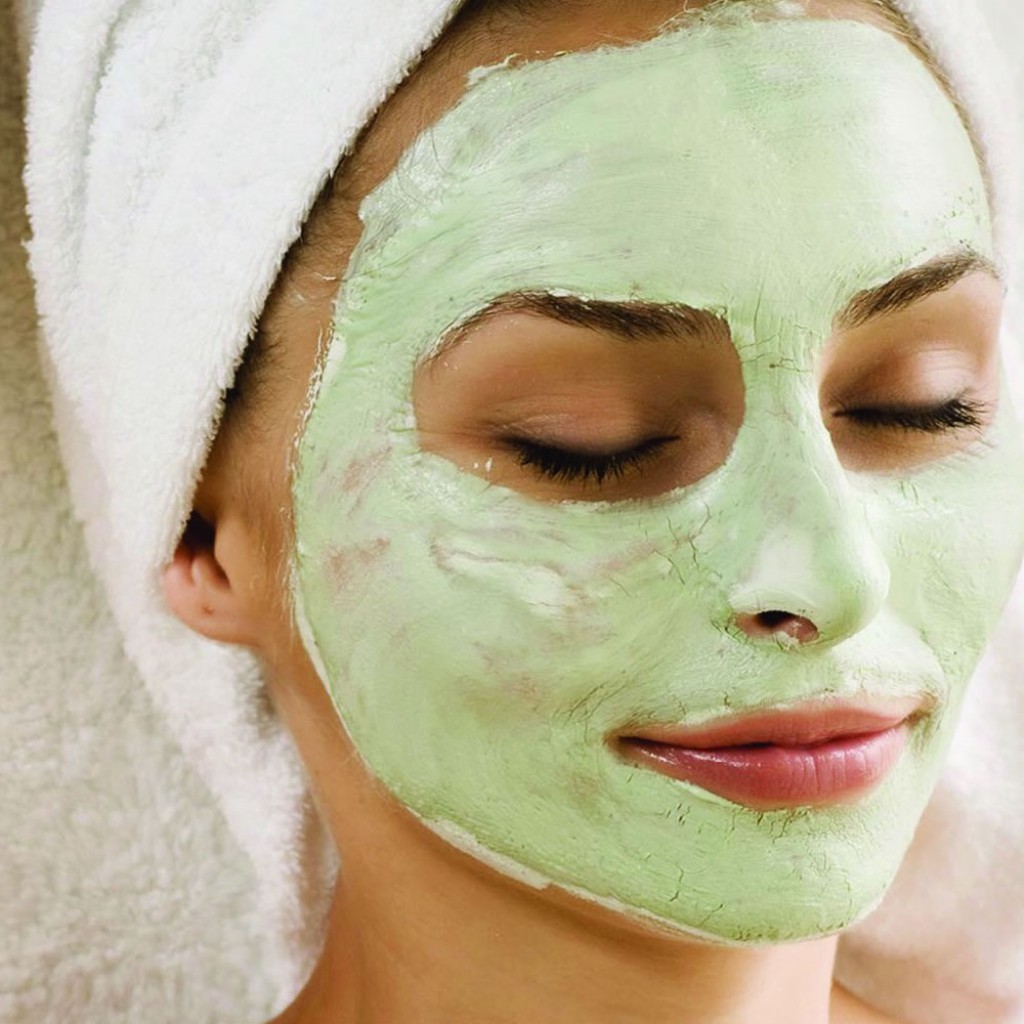 With regular use of the composition (2 times a week), the texture of the dermis noticeably improves, the complexion evens out, and oily sheen decreases.
With regular use of the composition (2 times a week), the texture of the dermis noticeably improves, the complexion evens out, and oily sheen decreases.
For oily skin, you can add 1 egg yolk, lemon juice (2 ml) and juniper berry to the mask. essential oil(1 drop). It is advisable for owners of dry dermis to use cabbage in boiled form.
The mask has a moisturizing, whitening, toning and anti-inflammatory effect on the skin. The frequency of use is 1 time per week.
 The composition is used to combat, comedones and "black dots".
The composition is used to combat, comedones and "black dots".
The tool is used to eliminate excessive dryness of the skin, brighten the tone of the face, reduce the number of acne.
Cabbage juice is effective in the fight against vitiligo and warts. To reduce foci of depigmentation, freshly squeezed nectar is applied to the affected skin once a day (at night).
In the food industry, both stem and cruciferous leaves are used. Kohlrabi cabbage is suitable for almost all types of heat treatment: boiling, baking, frying, pickling, sourdough, preservation, steaming or grilling. However, to preserve nutrients, the product is best used raw (especially when losing weight).
The stem "turnip" is used as an independent meal or as part of vegetable cuts, first courses, meat side dishes and puddings. It goes well with tomatoes, carrots, dill, onions, shrimp, and. Experienced chefs prepare fillings for pies, pancakes and dumplings from kohlrabi (in combination with other ingredients).
To enhance the taste, cabbage can be seasoned with lemon juice, cheese dressing, soy sauce, mayonnaise or olive oil.
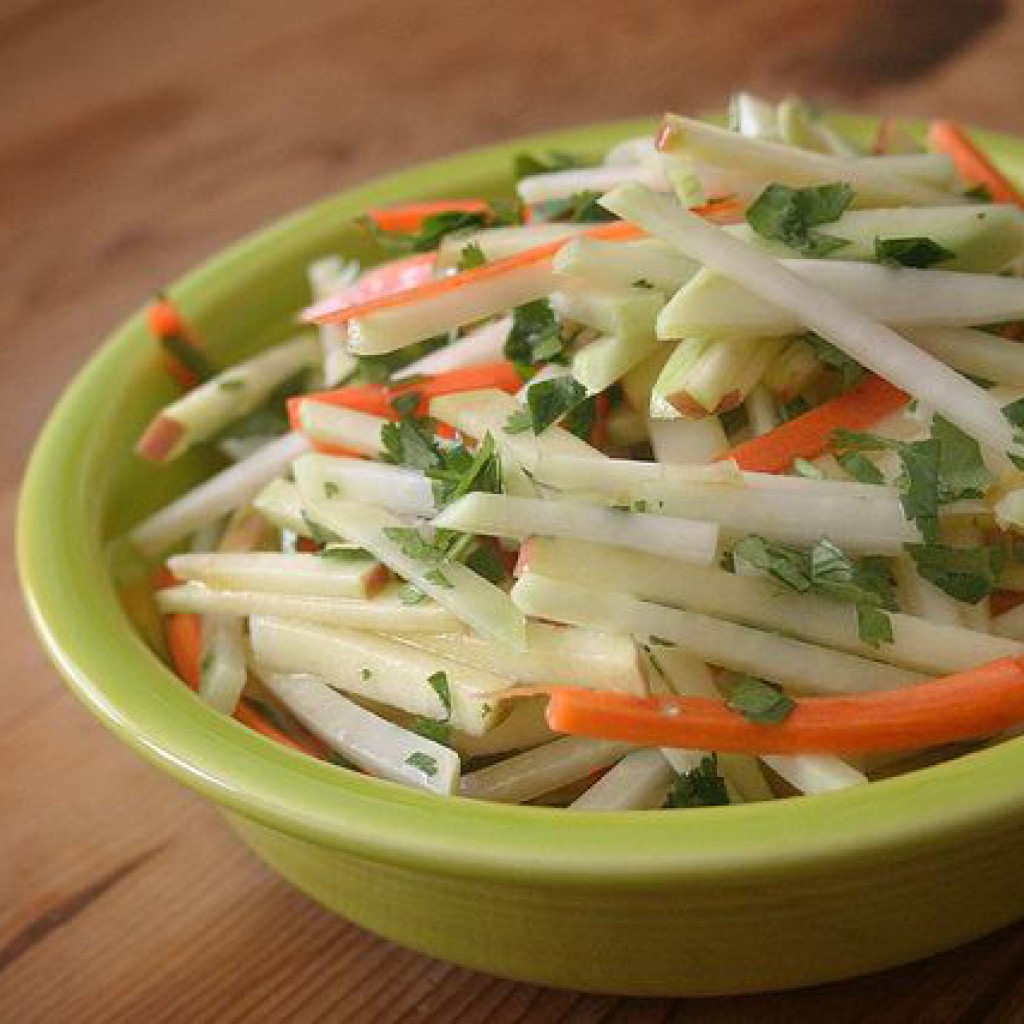 Remember, the smaller the root crop, the sweeter it is.
Remember, the smaller the root crop, the sweeter it is.
Small black dots on the tops of the cabbage signal a supersaturation of cabbage with nitrates.
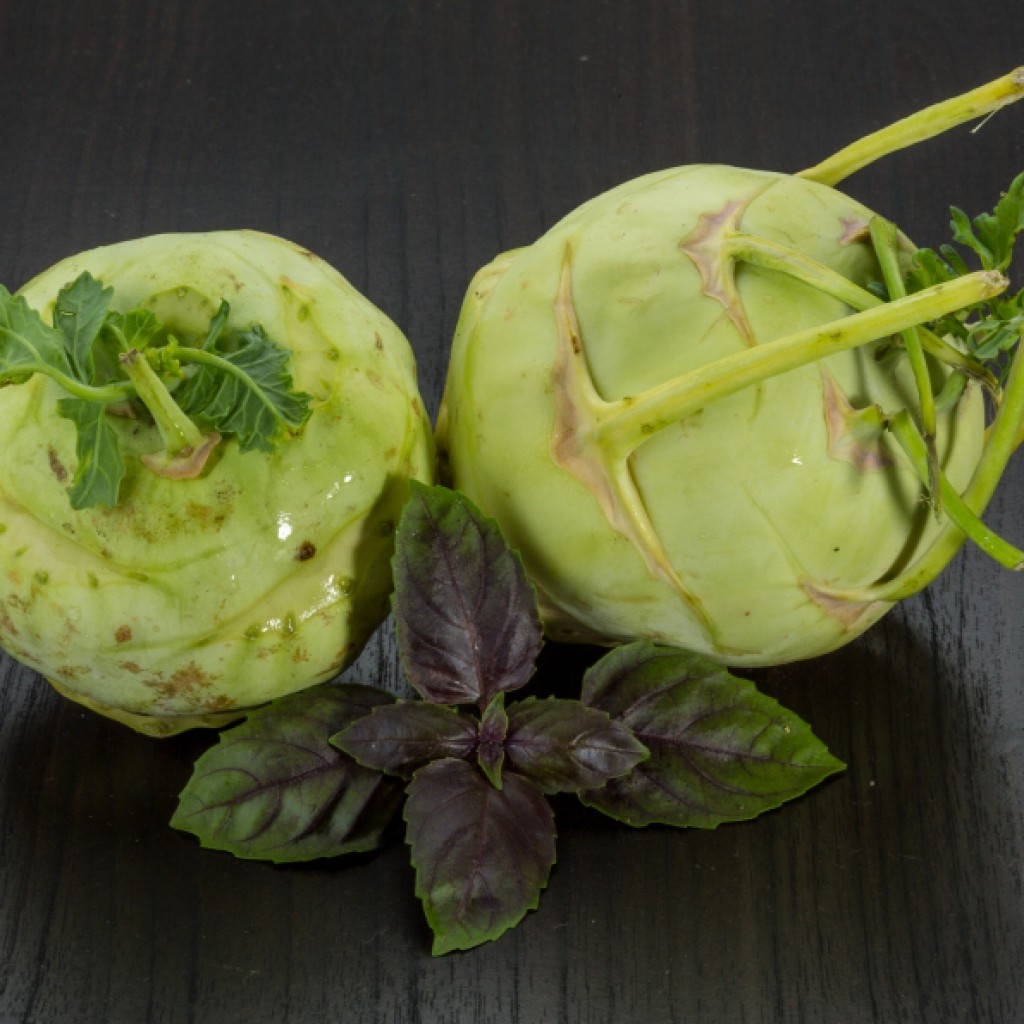 Components:
Components:
Cooking principle:
Before serving, garnish the cabbage soup with a sprig of greens.
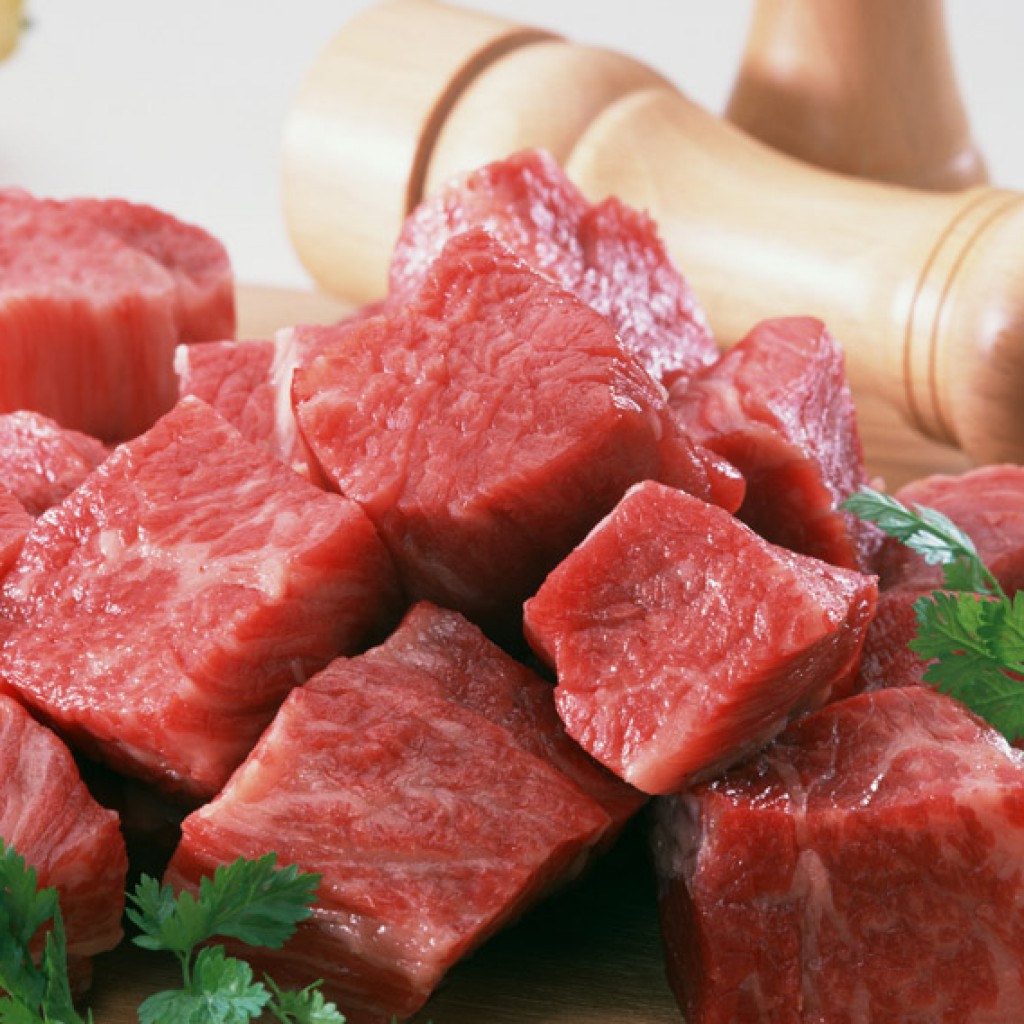 Components:
Components:
Cooking scheme:
Cooking method:
The pickling period for pickles is 3-4 days. The snack is stored at a temperature of 0 to + 5 degrees for no more than 3 weeks.
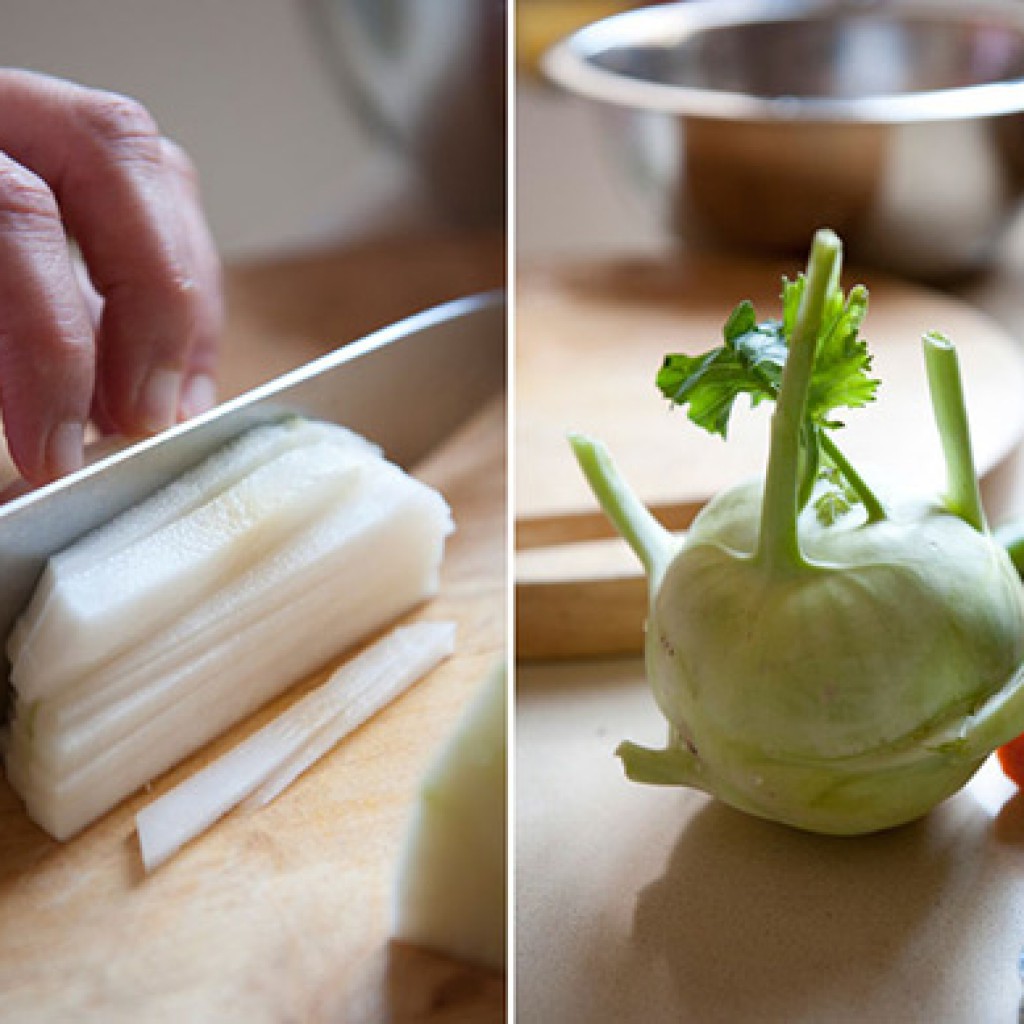 Components:
Components:
Cooking principle:
Salad goes well with meat side dishes.
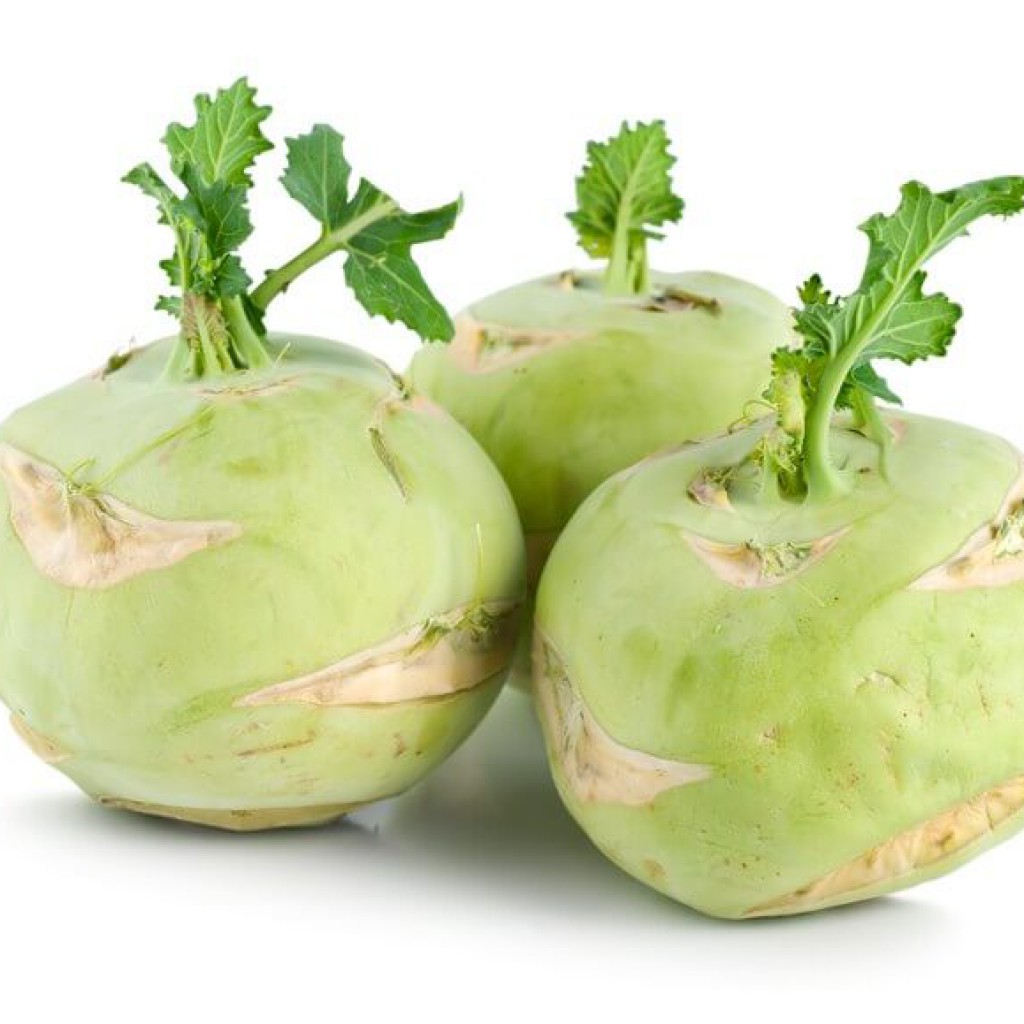 Kohlrabi cabbage is a highly nutritious product widely used for food, pharmacological and cosmetic purposes. The composition of stem crops includes easily digestible carbohydrates, vitamins (A, C, B1, B4, B5, B6, B9, PP, E), minerals (potassium, phosphorus, magnesium, calcium, zinc, copper), dietary fiber, enzymes.
Kohlrabi cabbage is a highly nutritious product widely used for food, pharmacological and cosmetic purposes. The composition of stem crops includes easily digestible carbohydrates, vitamins (A, C, B1, B4, B5, B6, B9, PP, E), minerals (potassium, phosphorus, magnesium, calcium, zinc, copper), dietary fiber, enzymes.
To minimize the likelihood side effects on the product from the body (flatulence, heartburn, pain), cabbage juice should be taken only in a warm form. Heat treatment destroys harmful ether.
Kohlrabi juice is used as part of cosmetic masks and peels (to improve skin structure). In addition to nutritional and pharmacological properties, cabbage has an exquisite delicate nutty taste (with subtle notes of celery). In view of this, the stem "turnip" is used in cooking (raw and cooked). The pulp of kohlrabi goes well with meat, herbs, vegetables, seafood and legumes.
Kohlrabi is a type of ordinary white cabbage. The name translates as "turnip cabbage", because it visually resembles a root crop, only located not in the ground, but outside. In fact, this is not a root crop, but a thickened stem. That's what they eat.
To taste, it resembles the core of white cabbage, but much more tender, juicy, sweet and not so bitter. Another advantage over other types of cabbage is that kohlrabi does not cause flatulence, which allows it to be used both in the children's diet and in various diets.
The colors of kohlrabi are green and purple, but inside the stems are white.
Contains a large number of vitamin A C, glucose, fructose, potassium, sulfur, vitamins B1, B2, PP.
Kohlrabi is a low-calorie product (27 kcal per 100 g of product), normalizes metabolism, has a beneficial effect on the state of the nervous system, improves the functioning of the liver, gallbladder, lowers cholesterol, prevents the development of cancerous tumors, helps with anemia and colds, has a diuretic effect .
The rules for growing kohlrabi practically do not differ from the cultivation of other varieties of cabbage.
The main difference is that kohlrabi can be planted earlier, because it is not afraid of the cold, but ripens in 2 months from the moment of emergence. You need to use only young cabbage, the old one is quite tough and not so sweet. It can be planted by seed (directly into the ground) in early May, in 2-3 passes to extend the harvest period, then in June-July to ripen in autumn.
Planting technology - 60x40 cm for spring cabbage and 60x55 for late. Late varieties ripen up to 3 months.
planted at the age of 30 days starting from April. Sowing depth - 5-7 cm, humus is added, squeezed, watered, preferably mulched. In order for the stem crops to be juicy, regular watering is needed, but waterlogging should not be allowed. Loosening should also be carried out, but hilling is not required. It is not recommended to use pesticides and chemical fertilizers.
The main pest to be encountered when growing kohlrabi cabbage is the cruciferous flea. The best way to deal with it is to sift the ashes through a sieve and carefully powder the leaves after watering.
During the cold periods of the year, kohlrabi can be successfully grown in a greenhouse.
Dear visitors, save this article on social networks. We publish very useful articles that will help you in your business. Share! Click!
The achievement of a stem diameter of 7-8 cm is an indicator that kohlrabi is ready for use. For late varieties sizes up to 10 cm are acceptable. It is important not to miss the moment and harvest on time, otherwise, when overripe, the taste will drop sharply. When to harvest kohlrabi cabbage, you will understand if you taste at least once overripe - dry and tough.
It is necessary to pull out kohlrabi along with the roots, then cut off the roots and leaves with a knife (young leaves can be used for salads, but they are stored for no more than 2-3 days). The stalk can be eaten like an apple, just peel the skin. Kohlrabi is good for salads, soups, casseroles, stews, stuffing and pickling.
The average yield of kohlrabi cabbage is 1.5-2 kg per 1 m².
The optimum temperature for storing kohlrabi: + 1-0 ° С. Humidity - 95%. For storage, you can use basements, piles, trenches, unheated greenhouses. The collected stalks are cleaned of dirt, dried and sprinkled with sand. In this version, early varieties are stored for about 2 months, and late ones - 3-5 months.
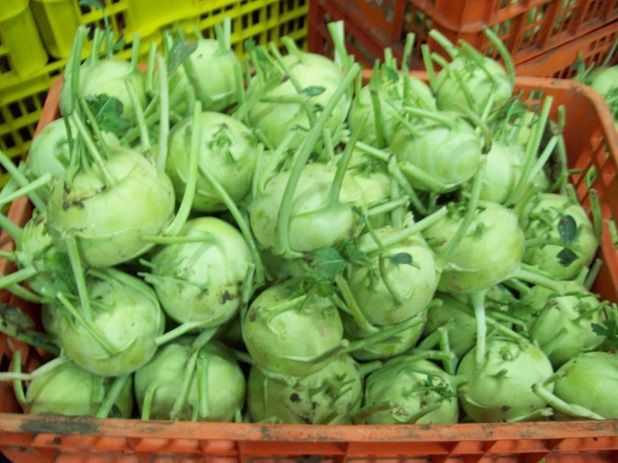
About a month can be in the refrigerator. It is not necessary to wash the stem crop - just wrap it in paper and put it in a plastic bag and place a moistened towel there. The package should not be closed.
The stem should be washed, peeled, cut into pieces and blanched for about 3 minutes, and then cooled in cold water. Thanks to this, the color and structure of the cabbage will be preserved. After that, we give the opportunity to dry the kohlrabi, pack it in bags or containers and send it to the freezer. In the freezer, kohlrabi cabbage can be stored for 9 months.
And some secrets...
Have you ever experienced unbearable joint pain? And you know firsthand what it is:
Now answer the question: does it suit you? Can such pain be endured? And how much money have you already "leaked" for ineffective treatment? That's right - it's time to end this! Do you agree? That is why we decided to publish an exclusive interview with professor Dikul, in which he revealed the secrets of getting rid of joint pain, arthritis and arthrosis.
It is worth asking even a child what place is the most delicious near cabbage, and he will answer without hesitation - a stalk. This is true, only it is not safe to use a cabbage stalk in our time. After all, it is in this part that contains the maximum amount of nitrates and other toxic substances. But cabbage has a relative that, in its taste, exactly resembles the taste of a stalk, only it is more tender and much juicier. This is kohlrabi.
This vegetable is a so-called stem crop. The core of this fruit is tender and juicy, very pleasant to the taste. Northern Europe is considered the homeland of kohlrabi. The name translated from German is interpreted as "cabbage turnip". The first mention of this vegetable was recorded in 1554, and literally a century later, kohlrabi spread throughout almost all of Europe, right up to the Mediterranean.
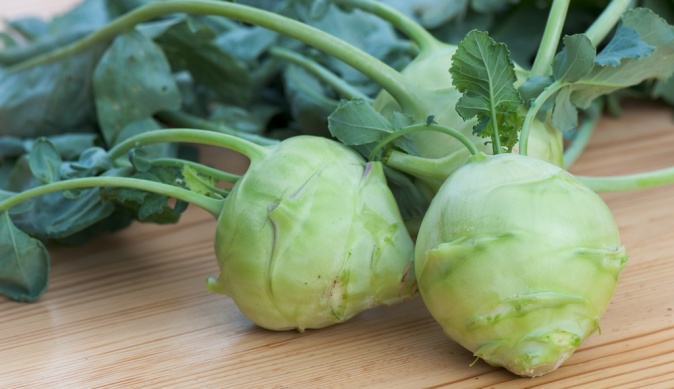
In the human diet, this type of cabbage appeared several centuries before the beginning of our era, and there is evidence that the inhabitants of the Roman Empire were the first to grow it - they generally loved cabbage. They called kohlrabi "kaulorap" - stem turnip, and the modern name of the plant comes from the ancient Roman.
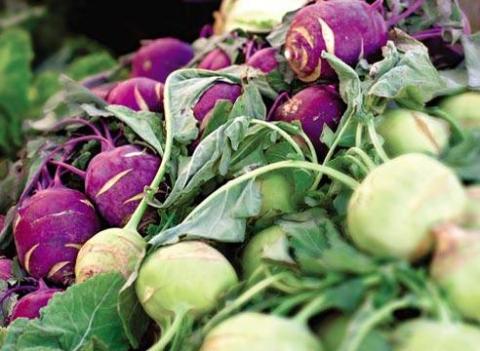
By appearance kohlrabi cabbage really very reminiscent of a turnip or radish, and its taste can be compared with the stalk of ordinary cabbage, but it is more tender and sweet. The so-called kohlrabi stem is used for food - a thickened stem that has a spherical shape and grows above the ground - just like a head of other types of cabbage.
The color of the kohlrabi stem can be very attractive.: light green, raspberry, dark or light purple, and the flesh of kohlrabi is always white, very juicy and with a pleasant taste. There are more nutrients in it than in white cabbage, but there is no bitterness and sharpness - due to the high content of sucrose.
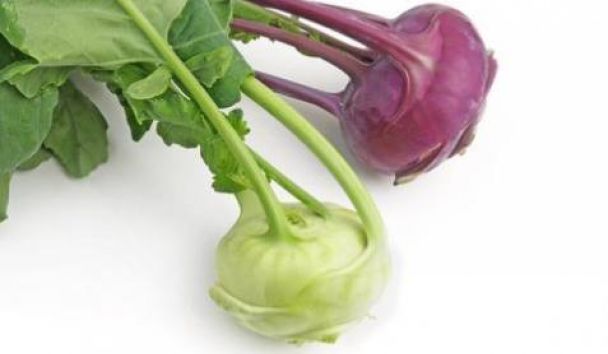
This vegetable is very unpretentious, resistant to pests and diseases and grows successfully even in the northern regions, due to its rapid maturation. Perfectly coexists in the garden with other cultures. But, unfortunately, despite all its advantages, kohlrabi is not appreciated at the proper level. It is grown in our country only at the amateur level.
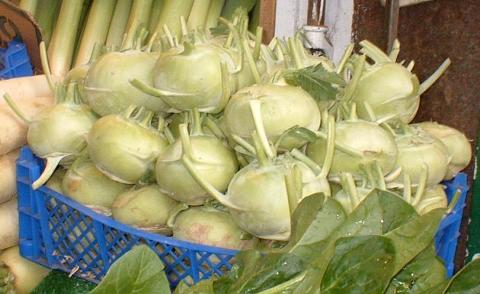
The composition of kohlrabi contains a large amount of vitamin WITH. There is more vitamin C in it than in lemon and orange, and there are very few calories - about 45 kcal per 100 g of product.
Kohlrabi has a very rich composition- It is literally saturated with vitamins and minerals. In addition to proteins, fats, carbohydrates, dietary fiber, kohlrabi pulp contains starch, natural sugars, enzymes, organic acids; vitamins A, C, E, K, PP, B vitamins, beta-carotene; macronutrients - calcium, magnesium, sodium, potassium, phosphorus, chlorine, sulfur; trace elements - iron, zinc, iodine, copper, manganese, selenium, fluorine, molybdenum, boron, aluminum, cobalt. The composition of kohlrabi includes enzymes, a large amount of vegetable proteins and carbohydrates.
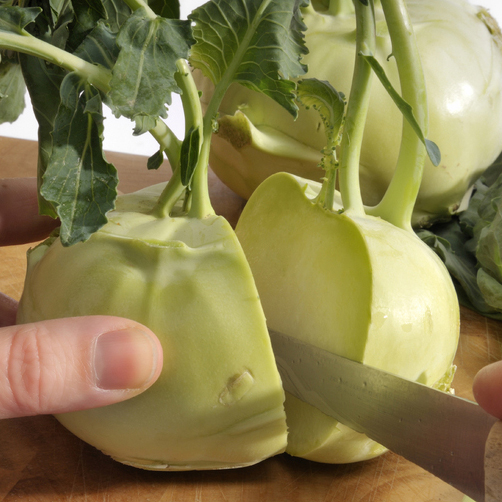
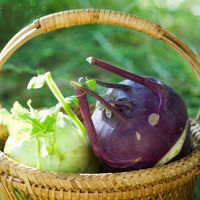 Kohlrabi cabbage is just a godsend for obese people, as well as for those who want to get rid of excess weight and maintain a slender figure.
Kohlrabi cabbage is just a godsend for obese people, as well as for those who want to get rid of excess weight and maintain a slender figure.
In addition to being low in calories, it contains tartronic acid, a substance that nutritionists call magical because it prevents carbohydrates from being converted into fat. This acid is also present in some other vegetables and fruits: cucumbers, eggplants, apples or quince, but it is especially abundant in kohlrabi. If you cook a kohlrabi salad with apples and fresh cucumbers, then this combination will really quickly help you magically get rid of excess weight.
Kohlrabi has a diuretic effect, cleanses the intestines of toxins, relieves inflammation in diseases of the gastrointestinal tract, normalizes blood pressure and makes the whole body stronger and healthier. Kohlrabi is not absorbed in the same way as white cabbage, but much easier, without causing bloating in the intestines and flatulence.
Research in gastroenterology shows that consumption of kohlrabi significantly reduces the likelihood of developing rectal cancer, since it contains a lot of sulfur compounds; as well as lung, breast, bladder and male genital cancers.
The functions of the liver and gallbladder are also restored when consumed. kohlrabi; appetite improves; diseases such as chronic gastritis, peptic ulcer of the stomach and duodenum, cholelithiasis are alleviated.
Slice kohlrabi can be given to children before meals, especially those who often refuse to eat main dishes.
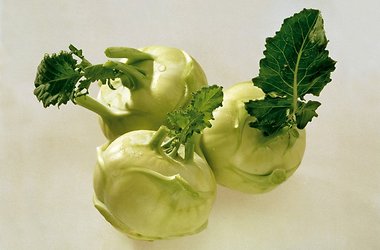
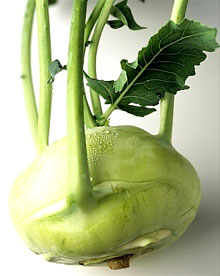
Kohlrabi juice is also useful and has a healing effect.: the calcium contained in it is in an easily digestible form, and is actively involved in the formation of bones and teeth. In general, the calcium content of kohlrabi can be compared with dairy products, eggs and cheese.
For the same reason kohlrabi and its juice are very important in the diet of pregnant women and people prone to osteoporosis.
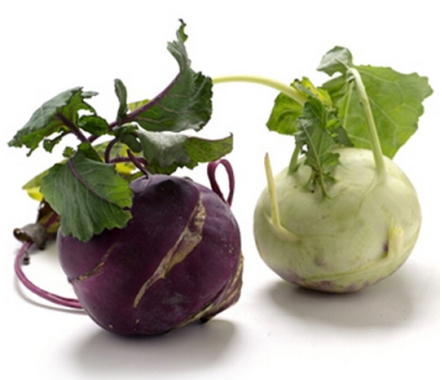
 The spectrum of usefulness of kohlrabi cabbage is very wide.: it helps with a lack of vitamins, has an anti-inflammatory effect, relieves swelling, removes toxins, destroys some pathogenic microbes, resists the development of atherosclerosis, improves blood composition and strengthens the immune system.
The spectrum of usefulness of kohlrabi cabbage is very wide.: it helps with a lack of vitamins, has an anti-inflammatory effect, relieves swelling, removes toxins, destroys some pathogenic microbes, resists the development of atherosclerosis, improves blood composition and strengthens the immune system.
With regular use of kohlrabi, metabolism improves, the work of the nervous system is restored; it is also recommended after infectious diseases, kidney diseases, diabetes and anemia.
It helps to remove excess fluid from the body, due to the content of potassium in it, and a large amount of fiber prevents the accumulation of cholesterol deposits.
IN folk medicine decoction kohlrabi and its tops have previously been successfully used to treat tuberculosis and bronchial asthma.
Kohlrabi is very easy to digest and does not cause flatulence, like most of its counterparts. This vegetable is a wonderful product for dietary and baby food.
The young leaves can also be eaten. kohlrabi, and not just a stem crop: they are put in soups and borscht, and more mature leaves are boiled or stewed, and then crushed and used to make side dishes, fritters, vegetable cutlets. In addition, the leaves contain more vitamin C than the stems themselves.
Before cooking, kohlrabi is peeled. In Germany they love stuffed and baked kohlrabi, and in France it is added to salads, roasts are cooked with it, and even soup is cooked.
Kohlrabi Recipes a bunch of. In cooking, kohlrabi is used in various forms.: it is baked, stewed and fried, even stuffed, but it is best to use it raw, for preparing various vitamin and dietary salads - with carrots, green onions, dill, celery, apple and cucumber. Tender and juicy salads are obtained from it, which can be seasoned with both vegetable oil and mayonnaise.
Kohlrabi is undoubtedly a component of proper nutrition. This vegetable is well stored and can please our eyes and, of course, the body almost throughout the year.
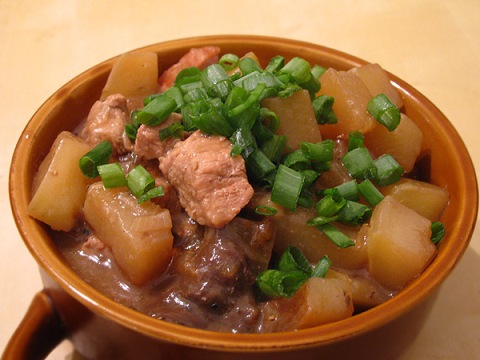
Peel 4-5 medium kohlrabi from the top layer, cut it into slices, salt and bread each in flour. Melt 2 tbsp in a pan. butter and lightly fry the cabbage slices in it in small portions. Transfer each serving to a saucepan as it is ready, sprinkling with ground cinnamon and pepper. Mix a quarter cup of sour cream with 2 tsp. tomato sauce and pour the kohlrabi with this mixture. Close the pot with a lid and put on low heat. Stew for 30-40 minutes until the slices become soft, sprinkle with chopped dill, green onions or parsley when serving.
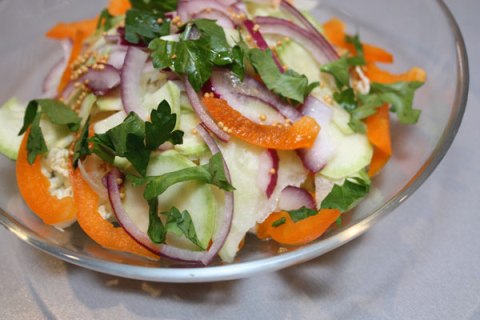
There are a lot of recipes with kohlrabi fresh salads. This one is the simplest, and at the same time very tasty and healthy.
Peel 1 large carrot, 2 cucumbers and a small, 200 gram, kohlrabi from the skin. Grate the cabbage and carrots on a Korean grater, and cut the cucumber into thin strips. Finely chop the parsley and dill. Combine all ingredients, add salt, pepper, sugar to taste. Stir and dress the salad with 2 tbsp. vegetable oil and a little lemon juice.
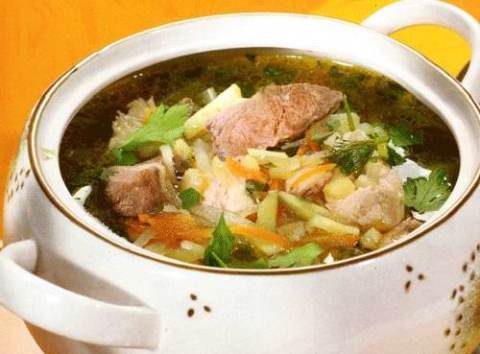
This recipe with kohlrabi is not quite ordinary, as traditional transparent soups are usually prepared with cabbage. Try to cook, you will surely like it.
Peel 3 potatoes, a head of onion and one medium head of kohlrabi, chop the vegetables randomly and fry in any butter or vegetable oil. Transfer them to a saucepan, pour 1 liter of vegetable broth into it and simmer for 10 minutes, covering the saucepan with a lid. Then pour in 5 tbsp. white wine, salt and pepper to taste. Using a blender, turn the contents of the pan into a soft puree. If you don't have a blender, you can pass everything through a sieve when the soup has cooled. In this case, it will need to be boiled again. In the finished soup puree, add 10 tbsp. whipped cream, pour it into bowls and put in each greens and chopped sausages or hunting sausages.
A very simple and tasty dish - kohlrabi in batter.
Pre-peeled and sliced large fruit kohlrabi boil in a small amount of salted water for several minutes, then dip each circle in a beaten egg, roll in flour and fry in oil until golden brown. Such kohlrabi is served cold, with sour cream or lemon juice, sprinkled with fresh dill or parsley. You can use it as a side dish for meat.
By the way, with meat kohlrabi it goes well together - nutritionists rate this combination of products “on the top five”, since the substances contained in this cabbage help the body easily absorb meat dishes, without any harm to health.
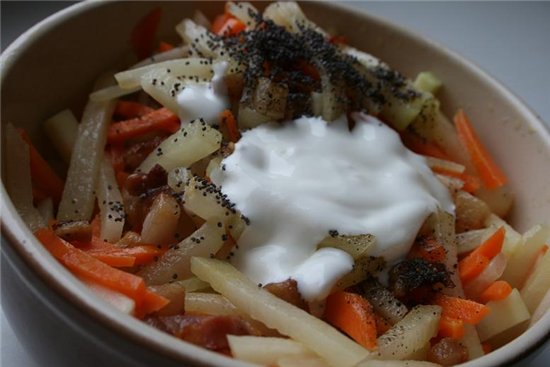
Very good salad kohlrabi with bacon - try to cook it at home.
To prepare 2 servings of salad, you will need 100 g of bacon, 200 g of kohlrabi and carrots, a little sour cream and ground cumin - 0.5 tsp. Diced bacon is fried in a pan and laid out on a paper towel to dry and remove excess fat. Carrots and kohlrabi, cut into thin strips, are blanched for several minutes in boiling water, then cooled and also dried. Vegetables are mixed with bacon and cumin, and dressed with sour cream.
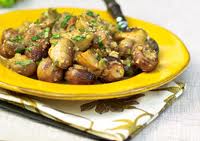
Ingredients:
Cooking:
Soak the mushrooms in warm water, then boil for half an hour. Peeled kohlrabi cut into cubes and boil in salted water.
Cut the boiled mushrooms into strips, strain the mushroom broth. Spasser the flour, add wine, 200 g of mushroom broth, cream and 400 g of kohlrabi broth, cook, stirring, for 10 minutes.
In the resulting sauce, add kohlrabi, mushrooms, salt, pepper and simmer for another 10 minutes. Serve the finished stew with young boiled potatoes and chopped herbs.
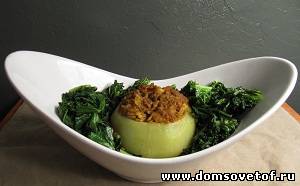 Ingredients:
Ingredients:
For sauce:
Cooking:
Clean the kohlrabi, score the top and scoop out the core. Pass the meat through a meat grinder along with onions, mix with scalded rice and chopped parsley, salt, pepper and mix.
Stuff the kohlrabi with the minced meat, fry until golden brown and transfer to a saucepan.
To prepare the sauce, mix tomato paste and flour with butter, dilute with broth, add salt, pepper and cook over low heat. Then strain.
Put the fried kohlrabi in the oven and pour the sauce on top. Bake for 20 minutes. Serve with sour cream.
 Ingredients
Ingredients
Ingredients:
Cut the peeled kohlrabi into slices and fry until golden brown. Season with pepper, salt and nutmeg.
Whisk eggs with milk in a bowl, add salt and pepper. Salmon cut into strips.
Pour the beaten eggs into the heated skillet.
Arrange kohlrabi mugs on plates, put scrambled eggs, salmon on top and garnish with herbs.
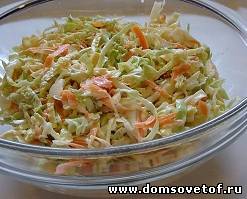 Ingredients:
Ingredients:
Cooking:
Peel kohlrabi and carrots from the skin, chop into strips on a coarse grater. Also peel the apple, remove the core and chop on a coarse grater. Mix all the ingredients, add lemon juice, salt and season with sour cream.
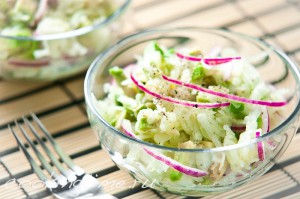
Ingredients:
Cooking method:
Grate kohlrabi on a coarse grater, cut avocado into small cubes, onion into thin half rings (do not add a lot of it, just a little, for a hint of taste). Mix everything, season with olive oil and lemon juice, pepper and salt to taste.
HOW TO PREPARE THE RECIPE:
Young kohlrabi is cleaned, washed and cut into small slices. Dipped in water slightly acidified with vinegar and boiled for 5 minutes.
The cabbage is thrown into a colander, allowed to cool and placed in jars. Water, sugar and salt are boiled and cooled, 5% or fruit vinegar is added and kohlrabi is poured.
Harvesting is best done in small jars, in which case you can get kohlrabi of different taste and aroma by adding dill, or garlic cloves, or basil, tarragon, lovage leaves to jars. Banks are closed and stored in the cold.
For marinade: for 1 liter of water - salt 50 g, sugar 80 g, vinegar 5% or fruit 100 g, spices, herbs, berries to taste.
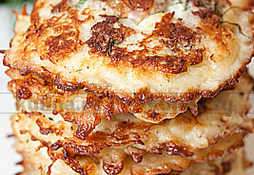 kohlrabi 500 grams
kohlrabi 500 grams
apple one piece
wheat flour three tablespoons
milk
0.5 cup
egg two pieces
sugar two tablespoons
butter one tablespoon
vegetable oil three tablespoons
sour cream
200 grams
salt to taste
step 1
Peel the cabbage and apple, cut into slices. Fry the kohlrabi in hot butter for 6 minutes. add apples and cook all together for another 8 minutes.
step 2
separate the yolks from the whites. beat the egg whites into a fluffy foam.
step 3
rub the cabbage and apples through a sieve. add flour, milk, yolks, sugar and a pinch of salt. Mix everything well and combine with whipped proteins. heat vegetable oil in a frying pan. Gently using a spoon
put the dough in the pan and bake the pancakes until golden brown, 2 minutes each. from each side. serve ready-made pancakes with sour cream.
Kohlrabi salad with apples, chicken and nuts
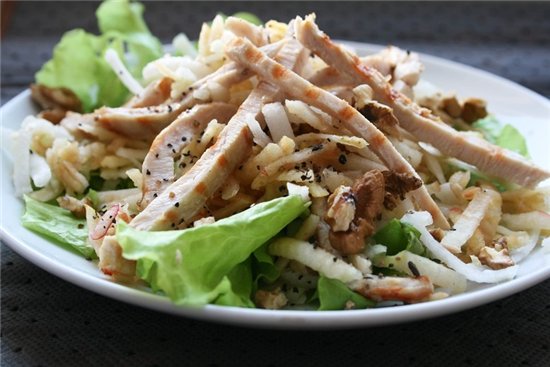
Ingredients:
400 g kohlrabi
2 apples (150 g each)
2 tbsp. l. lemon juice
80 g shelled walnuts
1 bunch of lettuce
2 chicken breasts (150 g each)
2 tbsp. l. butter
3 art. l. white wine vinegar
6 art. l. olive oil
1 st. l. chopped green onion
Salt, freshly ground pepper
Cooking:
Wash the apples, cut into 4 parts, remove the core. Cut into slices and drizzle with lemon juice. Peel the kohlrabi, cut into 4 parts and grate on a coarse grater. Coarsely chop the nuts.
Coarsely tear the lettuce with your hands, wash and dry.
Cut chicken breasts into strips.
Melt the butter in a frying pan, fry the chicken on all sides for 3-4 minutes. on medium fire. Lay out on paper towel, pat dry.
Make salad dressing by mixing vinegar, olive oil and green onion. Season with salt and pepper, then add the nuts to the sauce.
Mix green salad with apples, kohlrabi and chicken meat.
Drizzle with prepared dressing, stir and serve.
Kohlrabi cabbage (B.caulirapa) - a type of cabbage. The name comes from him. Kohlrabi, consisting of two parts "Kohl" - "cabbage" and "Rabi" - "turnip". In Rus', kohlrabi was associated with the root crop swede and called it "bukhma".
Botanical description
Kohlrabi is a biennial herbaceous plant that forms a thickened, short stem suitable for consumption in the first year of cultivation. Depending on the varietal characteristics, it can be flat-round or round in shape, having a color from light green, pale yellow to burgundy-purple.
In the second year of vegetation, the plant develops a tall flowering shoot from the apical bud with white or yellow flowers collected in a brush. As a result of flowering, a fruit is formed - a pod with many small, rounded, dark brown seeds. Weight 1 thousand pieces. - 3 g. They remain viable for up to 5 years.
Historical reference
Kohlrabi is an ancient culture. It was known as far back as the Roman Empire, where it served as a common food for the poor and slaves. In the 16th century, the popularity of this vegetable spread among German peasants, and then throughout Europe.
Today, kohlrabi is grown in America, Asia, as well as in many European countries. In Russia, this crop is cultivated on a limited scale, mainly in the northern and central regions.
Varieties and hybrids
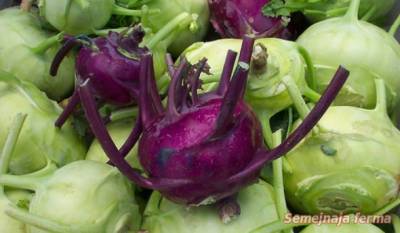
Among the modern varietal diversity of kohlrabi cabbage, 2 geographical groups are distinguished. The first one is called Asian. It includes varieties with a green color of the stem. When cultivated under conditions of long daylight hours, plants bloom in the first year of development, but do not form seeds.
The second European group includes varieties of kohlrabi with light green, yellowish and purple stems.
Due to limited use in Russia, the range of released varieties is rather poor. We mainly cultivate varieties of the Western European subspecies.
Viennese white 1350
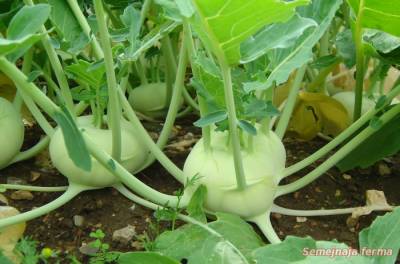
Ultra early variety. The duration of seedling development to the technical ripeness of the crop is 70 days. Stem-fruit is light-light-green, flat-round shape. Prone to rapid growth. The pulp is tender, juicy, tasty. Productivity up to 2.4 kg/m2. Allows cultivation in the warmed and open ground.
Optimus blue
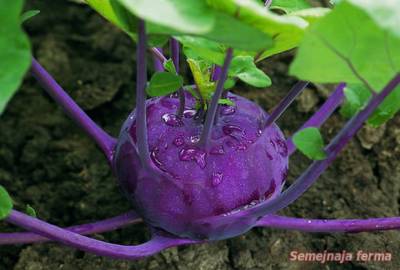
Early variety. The duration of the formation of the stem from the moment of germination is 80 days. The stem-fruit of purple color, round shape, compared with the variety described above, is characterized by greater resistance to overgrowth and longer keeping quality. Average weight 90 g. Yield up to 3 kg/m2.
Kossak F1
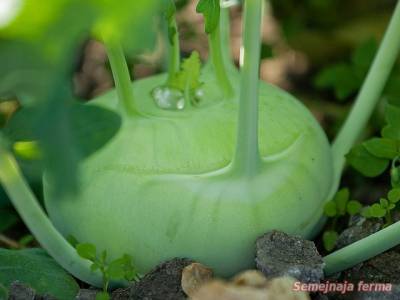
Late hybrid. Leaf rosette erect, dark green, with a waxy coating. The leaves are medium dissected, with a slight waviness along the edges. The stem is very large, weighing up to 0.6 kg. It is yellow-green in color, elliptical in shape, with a flat top. The pulp is whitish, excellent taste. The average yield is 2.2 kg/m2.
cultivation
Young kohlrabi plants are very cold hardy. They successfully withstand short-term cooling down to -5°С during the day and up to -10° at night. However, prolonged exposure to low temperatures is undesirable, as it causes coloring. Optimal temperature regime for the normal development of kohlrabi - 15-17 ° C.
This type of cabbage is demanding on soil fertility, preferring loamy soils rich in humus. When grown in adverse conditions, the stem crops are formed coarse and tasteless. For planting early varieties, it is better to select sunny beds, and shading is allowed for late-ripening varieties.
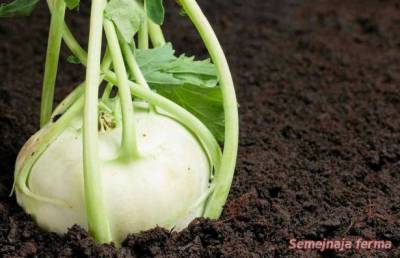
When choosing a landing site for kohlrabi, it is advisable to take into account predecessors. So, the best of them are tomatoes, legumes, potatoes, pumpkins, perennial herbs, zucchini. Moreover, their joint plantings are acceptable, where cabbage will play the role of a sealant. For this culture, it is undesirable to become a follower of root crops and immediate family members.
Due to the transience of the vegetative period of kohlrabi (up to 120 days), several crops of stem crops can be obtained per season. To do this, it is planted in 3 stages, growing through seedlings and sowing into the ground at different times.
Growing through seedlings.
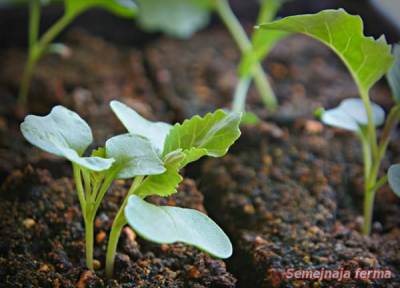
For the onset of technical ripeness of kohlrabi stalks in early June, it is recommended to grow this crop through seedlings. It is sown in early dates(until March 10) and grown in greenhouses. Until mid-May, depending on weather conditions, kohlrabi seedlings are moved to beds.
With later sowing of kohlrabi for seedlings (until mid-April), the plants are planted at the end of May and harvested in July.
In order to stock up on kohlrabi stem crops in autumn, seedlings are planted in early June, transplanted into open conditions in the second decade of July.
When planting seedlings, the plants are arranged according to the scheme of 60x20 cm or 50x25 cm. When using the two-line tape method, the interval between adjacent plants is reduced to 15 cm, and the distance between the tapes is increased to 60 cm. three rows.
Direct sowing.
With the seedless method of growing kohlrabi, sowing seeds in open ground is carried out from May 10, in mid-June and in early July. Seeds are placed on prepared beds with a leveled surface, distributing them along the planting holes located at a distance of half a meter.
After the emergence of seedlings and the formation of 2 true leaves on them, the plants are thinned out, increasing the distance between them to 15 cm. A month later, repeated thinning is performed, as a result of which the interval between plants will be 20-25 cm.
From the moment of planting seedlings or re-thinning, care for kohlrabi becomes the same. It consists in the regular implementation of standard agricultural practices: watering, fertilizing, loosening, weeding.
So, when the size of the stem crops reaches 15 mm in diameter, it is necessary to perform the first liquid nitrogen-containing top dressing. The consumption rate of the finished solution is 3 l / m2.
Kohlrabi needs regular watering, but does not tolerate excessive soil moisture.
After each watering, surface loosening of the row spacing to a depth of no more than 5 cm is necessary. At the same time, hilling of the bases of the stem should be avoided so as not to provoke cracking of the stem crops and the formation of wormholes.
Harvesting
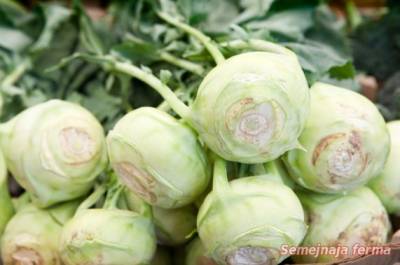
Kohlrabi harvesting is performed selectively as soon as the stem crop reaches 8 cm in diameter. But the main criterion for determining the timing of harvesting is the qualitative characteristics of stem crops (tenderness, juiciness, taste). Untimely collection leads to the loss of the properties of stem crops. They become woody, fibrous, tasteless.
When harvesting, kohlrabi stems are cut with a sharp knife at the very base. Leaves are removed later, before use. On average, from each harvest wave, you can count on 3 kg of stem crops per 1 m2.
Long-term storage of kohlrabi is possible at a temperature of 0C and a relative humidity of 95%.
Beneficial features
Kohlrabi cabbage is considered a valuable dietary product. It contains a wide range of vitamins, incl. and C-vitamin. Because of its high content, kohlrabi began to be called the "northern lemon." In addition, this vegetable is rich in mineral trace elements. In 100 g of kohlrabi there is more than 90 mg of calcium (which is several times higher compared to other types of kaputa), 380 mg of potassium, 1.4 mg of iron, 3.5 g of vegetable proteins, 1.6 g of fiber, 0.5 g pectins, as well as fructose, glucose.
The use of kohlrabi contributes to the normalization of the work of the nervous and cardiovascular systems, the stabilization of pressure, lowering cholesterol levels, and cleansing the intestines. The presence of tartronic acid and low calorie content (40 kcal) contribute to weight loss. The high content of calcium makes this product an essential ingredient in the diet of children and the elderly.
Kohlrabi in cooking
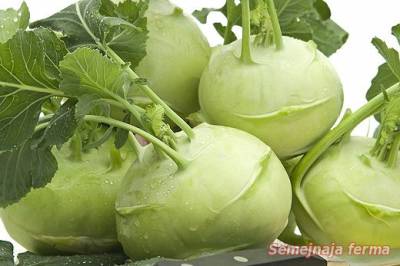
In cooking, kohlrabi becomes an ingredient various dishes in all sorts of conditions. It is fried, stewed, baked and even stuffed. It perfectly complements side dishes, goes well with meat and fish.
But fresh kohlrabi is especially good, being part of green salads. Vitamin and dietary “cocktails” are prepared from it, supplemented with apples, carrots, cucumbers, green onions, dill, celery and others.
In addition to kohlrabi stems, its young leaves can also be eaten. In terms of nutritional value, they even surpass fruits. So, in France, soups are cooked from them, they are added in stewed and chopped form to cutlets, side dishes, pancakes, etc.
The benefits of kohlrabi cabbage, harm and contraindications for use. In what conditions does this vegetable grow, what parts are edible. Recipes for home cooking and traditional medicine.
The content of the article:
Kohlrabi (Brassica oleracea) is a variety of edible garden cabbage, also known as "turnip cabbage" in Germany and "cabbage turnip" in Italy. Such names arose due to taste and appearance vegetable: it is visually similar to turnips and cabbages. The taste of kohlrabi is similar to white cabbage, turnip or radish, but surpasses them in some parameters: more juicy, there is no taste of bitterness or pungency. Unlike other cultures of the Cabbage species, in Russia, kohlrabi is not eaten with leaves, but with a stem. The vegetable was known in ancient Rome. It is believed that its place of origin is the eastern Mediterranean, probably Greece. "Cabbage turnip" is not demanding on growth conditions, although it is not very common, which is due to its low popularity in the CIS countries.
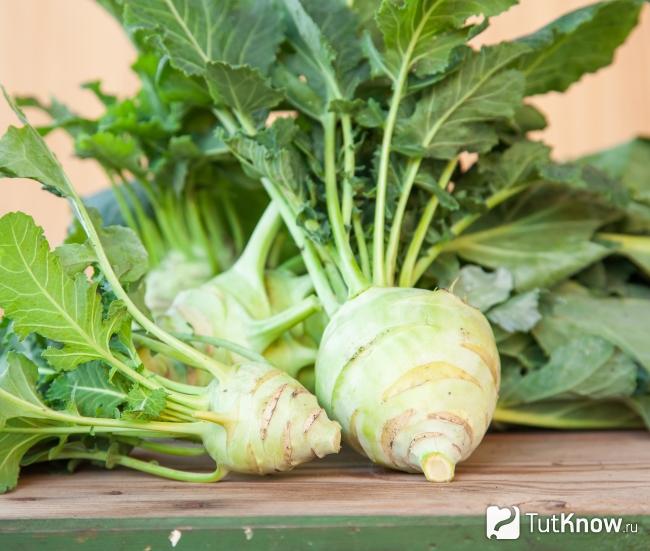
Calorie content of kohlrabi cabbage - 44 kcal per 100 grams of product, of which:
Kohlrabi is low-calorie, which allows it to be included in the diet menu as an ingredient in a vegetable salad seasoned with oil. In addition, if you compare the benefits and harms of kohlrabi cabbage, you can safely add it to the piggy bank of nutritious foods.
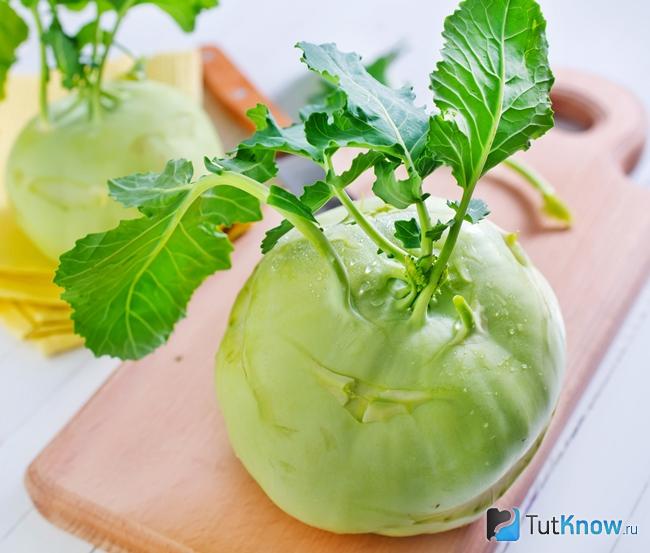
The benefits of kohlrabi cabbage and dishes with its content:
Note! It is recommended to use kohlrabi during breastfeeding, as this type of cabbage contains many useful substances in combination with low allergic reactions, which will improve the health of the baby with virtually no risk of any complications.

Kohlrabi should be used with caution in such situations:
Attention! Cases of individual intolerance are extremely rare, however, when the first symptoms appear, stop using the product and consult a doctor.
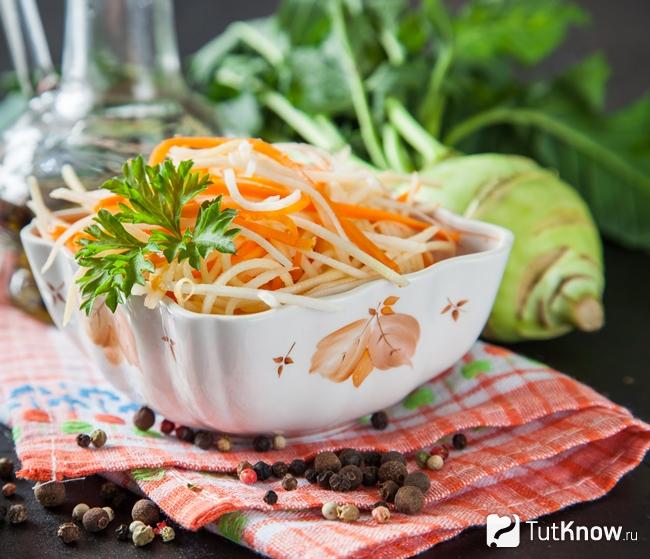
Those who have already tried kohlrabi compare its taste with the taste of a white cabbage stalk, but note that there is no unpleasant bitterness or sharpness, much more juicy pulp.
Below we will present you with several recipes using kohlrabi cabbage:
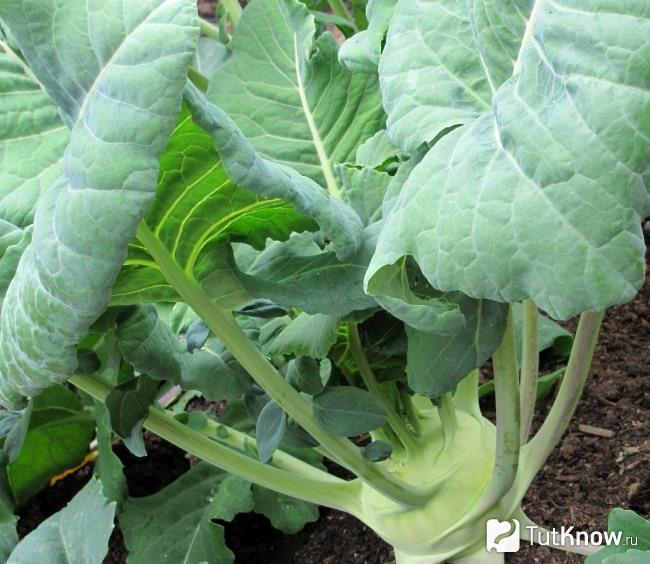
In folk medicine, kohlrabi is believed to increase appetite. But this does not mean that after a vegetable salad you will want to fried potatoes with mayonnaise. On the contrary, this amazing cabbage, combined with a low calorie content, will increase your appetite if you have problems with it. So, for the best effect, it is recommended to take 100 ml of juice 40-60 minutes before meals. In case of bronchial asthma, it is necessary to make a decoction of kohlrabi tops and take it during an exacerbation of the disease, and a decoction of the stem crop itself is regularly used for tuberculosis.
The color of the kohlrabi fruit varies from light green to dark purple, but the flesh is always white and juicy. The absence of spiciness or bitterness, compared with white cabbage, is due to the presence of sucrose in the “turnip cabbage”.
Kohlrabi cabbage in Russia was nicknamed the "northern lemon", due to the high content of vitamin C (more than in lemon), as well as the place of cultivation - the northern regions. But most gardeners consider this vegetable “frivolous” and unworthy of attention, preferring to grow ordinary white cabbage. So our compatriot hostesses continue to adhere to the opinion that "for vitamins and ordinary cabbage is enough." It's time to dispel this myth by turning to the scientific data on the benefits of kohlrabi, and include it in the list of must-have menu items!
What to cook with kohlrabi cabbage - look at the video: